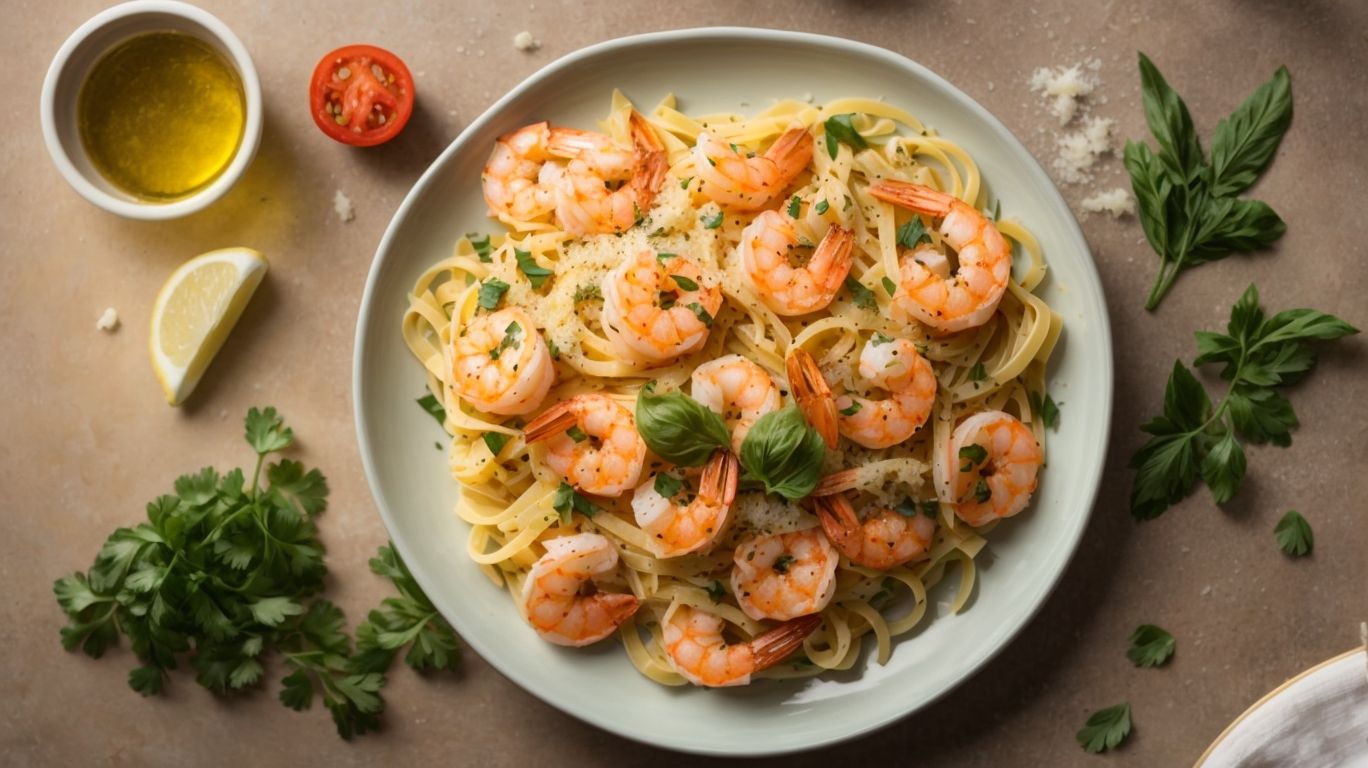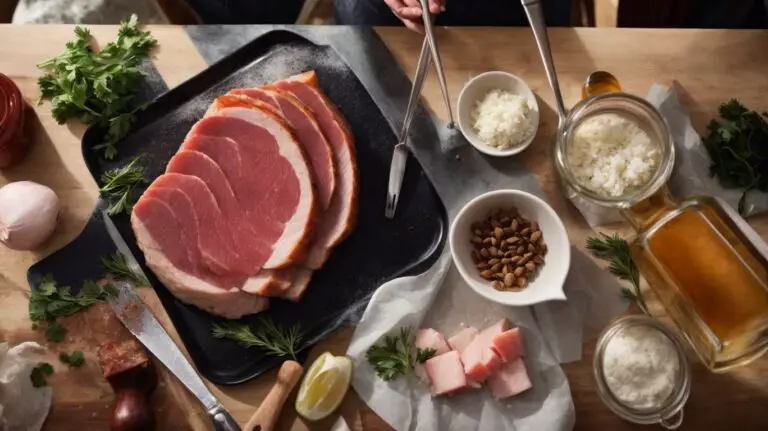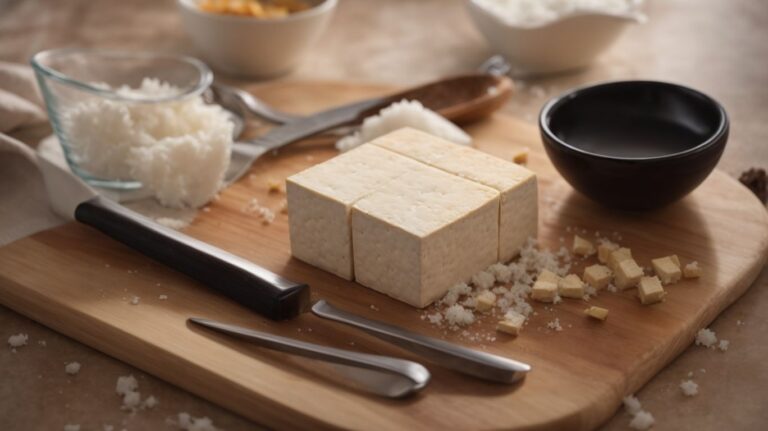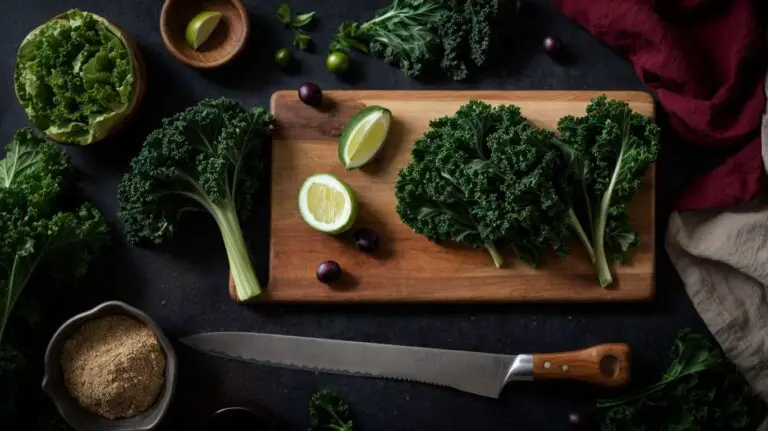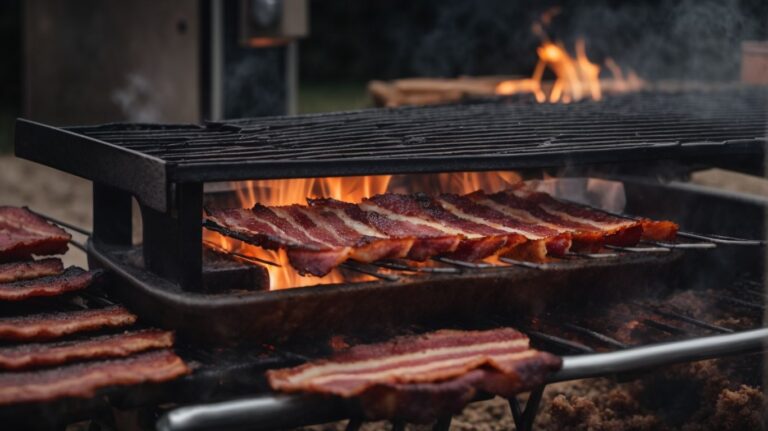How to Cook Pasta With Shrimp?
Are you ready to elevate your cooking game with a delicious pasta dish featuring succulent shrimp?
We will guide you through the essential ingredients you need, from pasta to sauce, as well as how to prepare the shrimp to perfection.
Learn how to cook the pasta just right and create a flavorful sauce to complement the dish.
We’ll also provide tips on plating and serving this mouthwatering creation. Let’s get cooking!
Key Takeaways:
What Ingredients Do You Need?
Creating a delightful shrimp pasta dish requires a blend of key ingredients such as shrimp, a rich and creamy sauce, garlic butter, and a touch of parmesan to elevate the flavors.
For the creamy sauce, a combination of heavy cream, butter, and Parmesan cheese is essential to achieve that luscious texture and decadent taste.
Garlic butter adds a savory depth that perfectly complements the sweetness of the shrimp, infusing every bite with a rich and aromatic profile.
Incorporating fresh herbs like parsley or basil can bring a burst of freshness to the dish, balancing the richness of the sauce and adding vibrancy to the overall flavor palette.
Pasta
The foundation of any shrimp pasta recipe lies in selecting the perfect pasta shape, whether it’s al dente linguine or classic spaghetti.
Linguine, with its long, flat noodles, complements shrimp beautifully, allowing the sauce to coat each strand perfectly. It’s important to cook linguine until it is firm to the bite, known as al dente.
On the other hand, spaghetti, a staple in Italian cuisine, offers a more delicate texture to the dish. Boil it until just tender for a more traditional take on shrimp pasta.
Besides linguine and spaghetti, other great options for shrimp pasta include penne, fettuccine, or even angel hair pasta, each offering a unique mouthfeel and flavor absorption.
Shrimp
Preparing the shrimp involves essential steps like cleaning, deveining, marinating, and cooking them to perfection for a succulent seafood addition to your pasta dish.
In terms of cleaning shrimp, start by rinsing them under cold water to remove any dirt or debris. Use a sharp knife or shrimp tool to carefully devein the shrimp by making a small slit along the back and removing the dark vein. For marinating, a mixture of olive oil, minced garlic, lemon juice, and a sprinkle of salt and pepper can enhance the flavor. Let the shrimp sit in the marinade for at least 30 minutes to absorb the flavors.
Vegetables and Herbs
Enhance the vibrant flavors of your creamy shrimp pasta by incorporating fresh vegetables like parsley and a hint of citrusy lemon juice for a burst of freshness.
These additions not only bring a pop of color to your dish but also introduce a variety of textures and aromas. Fresh parsley adds a herbaceous note, while the lemon juice offers a tangy zing that cuts through the richness of the creamy sauce.
The combination of these ingredients creates a harmonious balance, enhancing the overall taste profile of the dish. The parsley adds a bright, fresh element, while the lemon juice provides a refreshing contrast.
Sauce
The heart of a decadent shrimp pasta recipe lies in a luscious cream sauce infused with the aromatic flavors of garlic and butter, creating a harmonious blend that coats each strand of pasta.
To prepare this luxurious sauce, start by finely mincing several cloves of garlic to release their pungent aroma. In a pan over medium heat, melt a generous amount of butter until it turns golden and adds a nutty flavor to the base. The marriage of garlic and butter creates a foundation for the creaminess that follows.
Next, gradually pour in heavy cream, stirring constantly to prevent any lumps from forming. The cream will thicken and turn into a velvety smooth consistency, enveloping the shrimp and pasta in its rich embrace.
How to Prepare the Shrimp?
Mastering the art of preparing shrimp for your pasta dish involves meticulous steps such as cleaning, deveining, marinating, and cooking the succulent seafood to perfection.
Begin by gently rinsing your shrimp under cold water to remove any excess dirt or residue. Pat them dry with a paper towel to ensure they cook evenly.
Next, carefully devein the shrimp by making a shallow incision along the back and removing the dark vein. This step not only improves the appearance but enhances the flavor.
Marinating the shrimp in a flavorful mix of herbs, garlic, and lemon juice for at least 30 minutes adds depth to the taste profile.
In terms of cooking, use a hot pan with olive oil to sear the shrimp quickly, retaining their natural juices and enhancing their texture.
Cleaning and Deveining the Shrimp
Before incorporating shrimp into your pasta creation, ensure to properly clean and devein them to guarantee a delectable and visually appealing final dish.
This process is crucial for not only enhancing the taste of your dish but also for removing any unwanted bits that may impact the overall dining experience. To start, place the shrimp on a cutting board and make a shallow cut along the back with a sharp knife. Gently remove the dark vein using the tip of the knife or a deveining tool. Rinse the shrimp under cold water to ensure they are clean and then pat them dry before cooking.
Marinating the Shrimp
Infuse your shrimp with delightful flavors by marinating them in a blend of herbs, spices, and a hint of citrus for a zesty addition to your pasta masterpiece.
When marinating shrimp for pasta dishes, consider incorporating a mix of fresh herbs like parsley, basil, and thyme to bring out their natural sweetness. The addition of garlic and a splash of lemon or lime juice can provide a zingy kick that complements the seafood perfectly. This infusion process not only adds depth to the shrimp but also helps to tenderize them, resulting in a juicy and flavorful bite in every mouthful. Experiment with different combinations to find your personal favorite herb and citrus pairing for a truly sensational shrimp pasta experience.
Cooking the Shrimp
Cooking the marinated shrimp to perfection involves precise techniques to ensure a tender and flavorful seafood element that harmonizes beautifully with your pasta creation.
To achieve the ideal texture, consider searing the shrimp in a hot pan for a short time, just until they turn pink and slightly firm. Avoid overcooking as this can make the shrimp tough and rubbery.
Another method is to grill the shrimp, which adds a smoky flavor that pairs wonderfully with the creamy pasta. For a more delicate touch, poaching the shrimp in a flavorful broth can result in a juicy and succulent texture that enhances the overall dish.
How to Cook the Pasta?
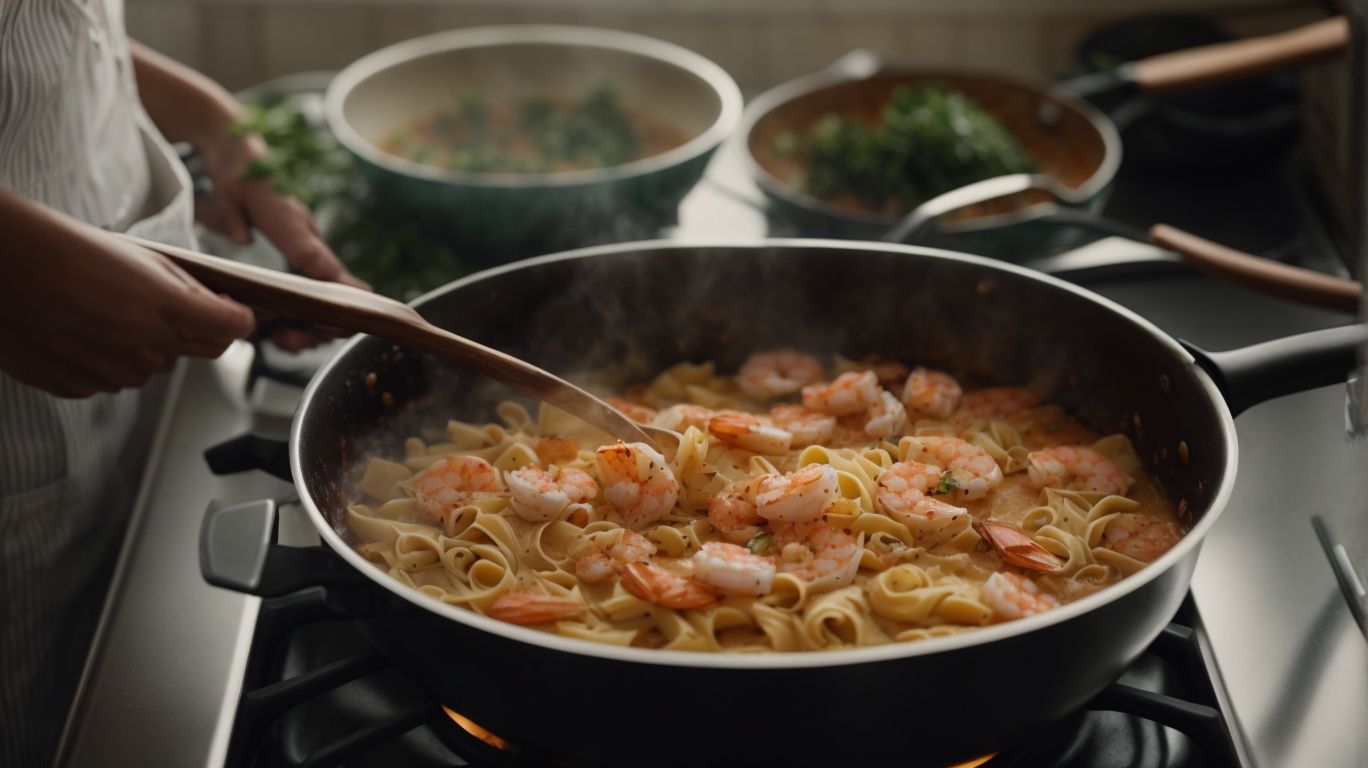
Credits: Poormet.Com – Juan Young
The art of cooking pasta to al dente perfection involves selecting the right shape, boiling it to the ideal texture, and ensuring it complements the flavors of your shrimp dish.
In terms of different pasta shapes, each one has a specific purpose. For instance, long pasta like spaghetti or linguine pairs well with light, oil-based sauces, while shapes like penne or rigatoni are ideal for capturing thicker sauces. Understanding these nuances can elevate the overall dining experience.
Boiling pasta to al dente requires testing it a few minutes before the package instructions indicate it’s done. The pasta should be tender but still have a slight firmness when bitten, providing a pleasant texture that enhances the dish’s flavors.
Achieving the perfect texture is crucial for a shrimp pasta recipe as it allows the pasta to absorb the flavors of the sauce while maintaining a delightful bite. Quality pasta cooked al dente can truly make a difference in the overall taste and presentation of the dish.
Choosing the Right Pasta Shape
Selecting the appropriate pasta shape, whether it’s the elegance of linguine or the classic appeal of spaghetti, plays a crucial role in enhancing the overall dining experience of your shrimp pasta creation.
In terms of linguine, its long, flat shape allows it to absorb sauces beautifully, making it a preferred choice for creamy or light seafood-based sauces like a delicate garlic butter sauce for your shrimp pasta.
On the other hand, spaghetti’s thinner, round shape works well with marinara or tomato-based sauces that cling effortlessly to each strand, creating a harmonious blend of flavors with the shrimp.
If you’re looking beyond linguine and spaghetti, varieties like fettuccine or penne can also complement shrimp dishes wonderfully. Fettuccine’s wider shape adds a luxurious touch, perfect for rich, Alfredo-style sauces with shrimp, while penne’s hollow tubes can trap bits of shrimp and other ingredients, delivering bursts of flavor in every bite. Exploring different pasta shapes opens up a world of possibilities to elevate your shrimp pasta to a culinary delight that satisfies both taste and aesthetic preferences.
Boiling the Pasta
Mastering the art of boiling pasta to the perfect al dente consistency requires attention to detail, timing, and ensuring each strand retains its ideal texture for the shrimp pasta dish.
Start by bringing a large pot of generously salted water to a rolling boil. For each pound of pasta, use about 4-6 quarts of water to ensure proper cooking space. Adding the pasta to the boiling water, give it a gentle stir to prevent sticking. Follow the package instructions for the recommended cooking time, but remember to test the pasta a couple of minutes earlier to achieve that firm yet tender bite of al dente. Once ready, drain the pasta quickly, reserving a cup of cooking water to adjust the consistency of your sauce.
Cooking the Pasta Al Dente
Cooking pasta al dente, with just the right bite, is essential for creating a texturally pleasing base that pairs harmoniously with the creamy shrimp and sauce components of your dish.
To achieve the perfect al dente texture, start by bringing a pot of generously salted water to a rapid boil. Add the pasta and stir occasionally to prevent sticking. Timing is crucial – follow the package instructions but taste-testing a few minutes before is key. The pasta should offer slight resistance when bitten into, without being too soft. Al dente translates to ‘to the tooth’ in Italian, emphasizing this desirable texture. Draining the pasta promptly and rinsing it under cold water halts the cooking process and preserves the ideal chewiness.
How to Make the Sauce?
Crafting the ideal sauce for your shrimp pasta involves blending creamy textures with aromatic garlic and butter, creating a luxurious coating that enhances every bite of your dish.
Begin by finely mincing fresh garlic cloves to infuse the sauce with its distinctive flavor. In a saucepan, melt a generous amount of butter over low heat to provide a rich base for the sauce. Add a pinch of salt and pepper to season the mixture, elevating the overall taste profile. Once the butter is melted, slowly pour in heavy cream, stirring continuously to achieve a velvety consistency.
Simmer the sauce gently until it thickens slightly, allowing the flavors to meld together harmoniously. For a touch of complexity, consider incorporating a splash of white wine or a sprinkle of Parmesan cheese to deepen the flavors. The key is to balance the richness of the cream and butter with the sharpness of the garlic, creating a well-rounded sauce that complements the delicate sweetness of the shrimp.
Choosing the Base for the Sauce
Selecting the perfect base for your creamy sauce, whether it’s a rich cream base or a velvety butter sauce, sets the tone for a decadent shrimp pasta experience.
A creamy foundation plays a crucial role in harmonizing the flavors of the dish, creating a luscious texture that coats each shrimp and pasta strand with indulgent goodness. Cream-based sauces, like an Alfredo sauce, provide a luxurious richness, while butter sauces contribute a silky smoothness that enhances the natural sweetness of the shrimp.
Exploring different sauce bases opens up a world of possibilities, from experimenting with herb-infused creams to discovering the perfect balance of buttery flavors. Each sauce base imparts its unique character, influencing the overall taste profile of the dish.
Adding Flavors and Seasonings
Infuse your sauce with a medley of flavors and seasonings, from aromatic garlic to savory herbs, to create a nuanced profile that complements the shrimp and pasta components of your dish.
Garlic, with its pungent and earthy notes, can serve as a strong foundation for your sauce, enhancing the overall depth of flavor. Consider incorporating fresh herbs such as basil, parsley, or thyme to add a refreshing and vibrant essence to the dish. Experiment with a touch of red pepper flakes for a hint of heat that will tantalize your taste buds. A squeeze of lemon juice can provide a bright acidity that balances the richness of the sauce, creating a harmonious blend of flavors.
Combining the Sauce with the Pasta and Shrimp
Intertwining the creamy sauce with the perfectly cooked pasta and succulent shrimp creates a harmonious fusion of flavors that culminates in a delectable shrimp pasta dish.
When combining these elements, it is crucial to ensure that each component is coated evenly with the delicious sauce. This distribution allows every bite to carry the essence of the dish, ensuring a consistent and delightful experience throughout the meal.
Balance is key here – too much sauce may overpower the delicate flavors of the shrimp and pasta, while too little can lead to a dry and unsatisfying texture. Finding that sweet spot where each element shines while complementing the others is what elevates this dish from a simple pasta with shrimp to a culinary delight.
As the flavors meld together, the rich creaminess of the sauce enhances the natural sweetness of the shrimp and the subtle flavors of the pasta. This synergy creates a dish that delights the taste buds and leaves a lasting impression.
How to Plate and Serve the Dish?
Elevate the presentation of your creamy shrimp pasta by artfully plating the dish, garnishing it with a sprinkle of fresh herbs and vibrant vegetables for a visually stunning and flavorful experience.
One popular plating technique for shrimp pasta is to neatly twirl a portion of pasta and place it in the center of the plate, allowing the shrimp to be elegantly arranged around it. This creates a focal point for the dish and showcases the succulent shrimp. To add a pop of color and freshness, consider scattering chopped parsley or basil over the dish. These herbs not only enhance the visual appeal but also provide a burst of flavor. Complement the pasta with thinly sliced cherry tomatoes or roasted bell peppers for a vibrant finish that adds both texture and taste.
Plating the Pasta and Shrimp
Master the art of plating your pasta and shrimp creation by arranging the components elegantly on the dish, ensuring a visually appealing presentation that entices the palate.
When plating pasta and shrimp, consider the contrast of colors and textures to create an eye-catching dish. Play around with different heights and angles to add depth and dimension to your presentation. Utilize fresh herbs as garnishes not only for a pop of color but also for added flavor. Experiment with various plate shapes and sizes to find the perfect canvas for your creation. Remember, a well-plated dish is not just a feast for the taste buds, but also a feast for the eyes.
Garnishing with Herbs and Vegetables
Add a touch of freshness and color to your creamy shrimp pasta by garnishing it with vibrant herbs like parsley, and a squeeze of lemon juice for a zesty finish that elevates the dish.
In terms of garnishing, the options are endless. Plus parsley and lemon juice, consider topping your shrimp pasta with freshly chopped chives for a mild onion flavor or sprinkle some chopped dill for a hint of freshness. Experimenting with different herbs and vegetables not only adds visual appeal but also introduces a variety of flavors to your dish. Customizing your garnish allows you to tailor the taste profile to your liking, creating a unique culinary experience for every bite.
Serving and Enjoying the Dish
Savor the flavors of your meticulously prepared creamy shrimp pasta by serving it with flair and relishing every bite of the harmonious blend of pasta, shrimp, and creamy sauce.
For an elevated dining experience, pair your creamy shrimp pasta with a crisp white wine or a light and refreshing mixed green salad tossed in a zesty vinaigrette. The rich creaminess of the pasta beautifully complements the acidity of the wine, creating a perfect balance of flavors.
Consider garnishing your dish with a sprinkle of fresh parsley or grated Parmesan cheese to add a burst of freshness and depth to each mouthful. The hint of herbaceousness or the nutty notes of Parmesan can enhance the overall taste profile and elevate your culinary journey even further.
As you savor each forkful of the tender shrimp and al dente pasta coated in the luscious sauce, take a moment to appreciate the textures at play – the velvety smoothness of the creamy sauce contrasted with the slight firmness of the pasta and the succulent juiciness of the shrimp.
Make sure to serve your creamy shrimp pasta immediately while it’s still piping hot to fully enjoy the amalgamation of flavors and textures. Raising your dining experience beyond just a meal, this delectable dish will surely delight your taste buds and leave you craving for more.
Frequently Asked Questions
How to Cook Pasta With Shrimp?
Cooking pasta with shrimp is a popular dish that combines the delicious flavors of seafood and pasta. If you’re new to cooking this dish, check out these FAQs for some helpful tips.
What ingredients do I need to cook pasta with shrimp?
To cook pasta with shrimp, you’ll need pasta (of your choice), shrimp, olive oil, garlic, salt, pepper, and any additional seasonings or herbs you prefer. You can also add vegetables like bell peppers and cherry tomatoes for extra flavor and nutrition.
Do I need to cook the shrimp before adding it to the pasta?
It is recommended to cook the shrimp before adding it to the pasta. This helps prevent overcooking the shrimp and ensures that it is evenly cooked. You can cook the shrimp separately in a pan with olive oil, garlic, and seasonings before adding it to the pasta.
How do I prevent the shrimp from becoming rubbery?
To prevent the shrimp from becoming rubbery, make sure not to overcook it. Shrimp cooks quickly and overcooking it can make it tough and rubbery. Cook the shrimp just until it turns pink and is opaque in the center.
Can I use frozen shrimp for this dish?
Yes, you can use frozen shrimp for this dish. Just make sure to thaw it properly before cooking. Thaw the shrimp in the refrigerator overnight or in a bowl of cold water for quicker thawing. Do not use hot water as it can partially cook the shrimp and affect the texture.
How long does it take to cook pasta with shrimp?
The cooking time for pasta with shrimp varies depending on the type of pasta you’re using and how you like your pasta cooked. In general, it takes about 10-12 minutes to cook the pasta, and the shrimp can be cooked in about 5-7 minutes. So, the entire dish can be ready in under 20 minutes.

